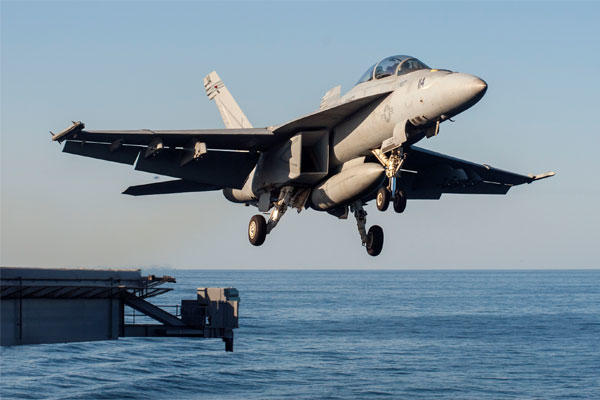The Navy is considering extending production of its F/A-18 Super Hornet beyond 2017 because of delays in production of the Navy's carrier-launched F-35C and increased demands on the Hornet fleet, service leaders said.
Navy leaders had planned to halt production of the F/A-18 Super Hornet at Boeing's St. Louis plant in 2017 as the service prepared to replace Hornets with Joint Strike Fighters.
In order to reduce operational risk, Navy aviation leaders have said the service needs two to three additional squadrons of Super Hornets as older F/A-18As, Bs, Cs and Ds reach the end of their useful service life.
"We have looked at the F-18 inventory as part of our overall inventory management. The CNO (Chief of Naval Operations) has testified that looking at our inventory from now into the mid-2020s and 2030s -- we need about two to three squadrons of Super Hornets to really reduce risk going forward as we procure F-35Cs," Rear Adm. Michael Manazir, airector of air warfare, told Military.com in an interview.
A carrier air wing consists of about 44 strike aircraft made up of two 10-aircraft squadrons and two 12-plane squadrons complemented by several electronic jamming aircraft. Therefore, the Navy's stated need for additional squadrons would require the addition of more than 20 new aircraft.
The current composition of most carrier-based air wings includes 24 Super Hornets and 20 Hornets. The Navy plans to replace the existing Hornets with F-35Cs.
Related video:
When the F/A-18A and F/A-18C reach 8,000 flight hours, they are sent into the depot for service life extension upgrades with the hope of getting the airframes to 10,000 hours. However, many of the older aircraft are in need of substantial repairs and, at the moment, as many as 54 percent of the Navy's fleet of older Hornets are not in service.
The depots cannot keep up with the demand to repair airplanes due to the deployment of F-18s, industry and Navy officials have explained.
"How many hours do I have left on the F-18-A and F-18C? I have to manage my procurement strategy to get an integrated air wing into the future," Manazir said.
The Navy had been planning for the Super Hornets to serve well into the 2030s, but now service leaders say that timeline will need to extend into the 2040s. Manazir explained that the Navy plans to begin buying 20 F-35Cs a year by 2020.
"I've been flying F-A-18s to the tune of about 350 hours per year per tail. If I am flying at that rate, I need to replace those airplanes -- 35 to 39 airplanes per year. As F-35C continues to push out and we are not buying 35 to 39 airplanes -- you will see a deficit. We need strike fighters. We need some relatively near term," Manazir explained.
The Navy recently placed 12 Super Hornets and eight Joint Strike Fighter F-35Cs on the 2016 unfunded requirements list, a wish list of extra items annually sent over to Congress as lawmakers prepare to mark up the annual budget.
The F/A-18 production line includes production of the F/A-18 E/F Super Hornet as well as the EA-18G Growler electronic warfare aircraft. So far, the Navy, Boeing and its partners have built and delivered about 500 F/A-18 E/F aircraft, Navy officials said.
Overall, the F-18 program plans to acquire 563 F/A-18E/F Super Hornets; however, that number appears to be on the rise. The A, C and D models are no longer being made.
Boeing officials have said they need to decide about the production line at some point later this year, indicating a need to make a decision about whether to buy what's called long-lead production items.
The F/A-18 industrial footprint spreads across 44 states and is responsible for more than $6 billion in estimated annual economic impact, including 90,000 direct and indirect jobs.
The Navy is considering a series of upgrades to the F/A-18 Super Hornet aircraft designed to increase the range and performance of the aircraft, Manazir added.
These proposed upgrades include the use of conformal fuel tanks, avionics enhancements and an external weapons pod designed to reduce the aircraft's radar signature.
If the Navy decides to pursue these Boeing-funded upgrades to the aircraft, it is possible the Navy could also buy more than the 563 proposed, Navy officials said. Citing affordability concerns, Manazir said it was unlikely that all of the proposed upgrades would take place simultaneously.
Manazir added that the Navy plans for the Super Hornet to operate with the F-35C, although plenty of questions remain whether the Super Hornets would neutralize the F-35's stealth characteristics.
The Navy is also involved in an ongoing joint study to assess the need for E/A-18G Growler jamming or electronic attack aircraft.
"We have enough Growlers to support the Navy mission, but what joint airborne electronic attack missions will we need to support in the future? Right now, we have 153 of them. If the joint fight requires more Growlers, then those would also come off the same line," he explained.
The rapid technological improvement of potential adversaries' air defense systems has created a circumstance wherein the F-35C's stealth technology will at times need to work in tandem with the support of Growler electronic jamming aircraft.
"Maneuvering inside all of the bands of the spectrum is very important. If there is a strike fighter that is optimized for a certain part of the spectrum, you have to worry about dominating the rest of the spectrum," Manazir explained. "If you are going to operate against high-end integrated air defense systems, you will have to have a combination of low-radar cross-section and probably some kind of jamming characteristics."
-- Kris Osborn can be reached at Kris.Osborn@military.com.





























